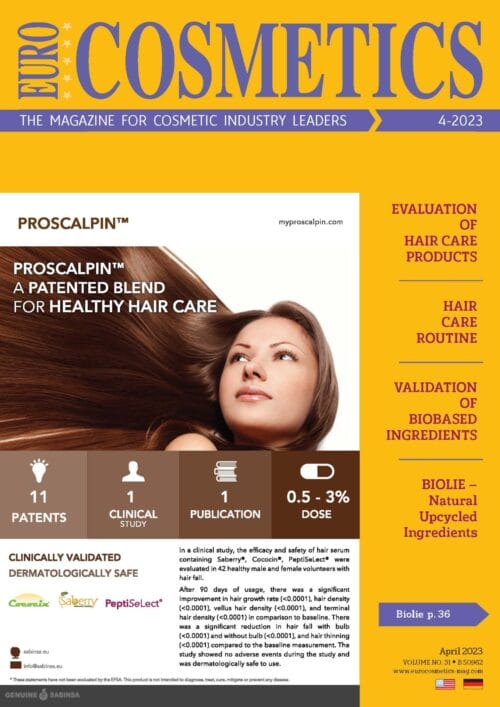
Summary
Shampoos and conditioners are essential part of routine for the hair care. We developed a general hair routine that includes shampoo and conditioner that have a preliminar performance in two types of hair: treated and natural. We evaluated 8 formulations in laboratory test, and we define two routines, to validate with the both users with natural and treated hair in a home test use. We found the routine 1 with a promissory performance and useful bases of formulation to start new projects in hair care.
Key words: Shampoo, Conditioner, Laboratory test, Hair routine, Home Test
Introduction
The global hair care market size reached US$ 82.3 Billion in 2022. According to IMARC Group it is expected to reach US$ 107.2 Billion by 2028 with a growth rate of 4.4% during 2023–2028. 1 The hair care market is one of beauty’s all-star categories in cosmetics industry where we can see high expectations by the consumers in products for basic care as shampoo and conditioner.
Shampoo in simple terms is a hair care product designed to clean the scalp skin along with its hairs. It cleans the scalp of dirt and other environmental pollutants, sebum, sweat, desquamated
corneocytes and other greasy residues including previously applied hair care products such as oils, lotions, and sprays, at the same time it must condition and beautify hair. Comercial shampoos contain a mixture of surfactants, conditioners, actives, emollients for providing optimum cleaning levels according to hair type and requirement – normal, oily, dyed, permed, colored, or damaged hair. 2
Hair conditioners are designed to improve hair manageability, decrease hair static electricity, decrease friction, detangle the hair improving combability and add luster. Conditioners act by neutralizing the electrical negative charge of the hair fiber by adding positive charges and by lubricating the cuticle that reduces fiber hydrophilicity. The ideal conditioner is capable of restore the hydrophobicity of the fiber and neutralize the static electricity. Depending on the capacity of entering the fiber, the conditioner may reach the cuticle surface or the inner part of the cortex. 3 The smooth feel resulting from conditioner use gives easier combing and detangling in both wet and dry conditions. 4
Weathering is the progressive degeneration from the root to the tip of the hair. Normal weathering is due to daily grooming practices. When the hair is extremely weathered and chemically treated, there may be scaling of the cuticle layers, removal of the 18-MEA and cuticle crack. If the cuticle is removed, the exposure of the cortex and further cortex damage may lead to hair fiber fracture. 3 The use of hair cosmetics as shampoo and conditioner routine may balance hair cuticle damage and prevent hair breakage by reducing friction and water pick up.
Proposal
Shampoos and conditioners are essential part of routine for the hair care and are responsible for helping the hair look healthy, manageable, shiny through their various ingredients. The balance between good cleaning and beautifying the hair is a challenge by cosmetic chemists achieved by mixing synergic ingredients in the correct proportion and the validation of the key parameters on the hair target (natural, colored, bleached, dyed, curly, straight etc.).
The hair look soft, shiny, and manageable is a key factor of decision for the customer now to re buy the product. We wanted to develop a general hair routine that includes shampoo and conditioner that could have a good performance in two types of hair: treated and natural. We ask it: What is the best formulation base to use in both natural and damage hair? With this question, we wanted to validate different formulations on tresses and then prioritize two routines to test with two types of consumer (Treated and natural hair).
Formulations
Firstly, we developed several formulations and choose four for each type of product (shampoo and conditioner) Table 1 and Table 2. The formulations selected were validate in preliminary stability at different conditions for one month (4° C, 40 °C, 60 ° C and cycles).
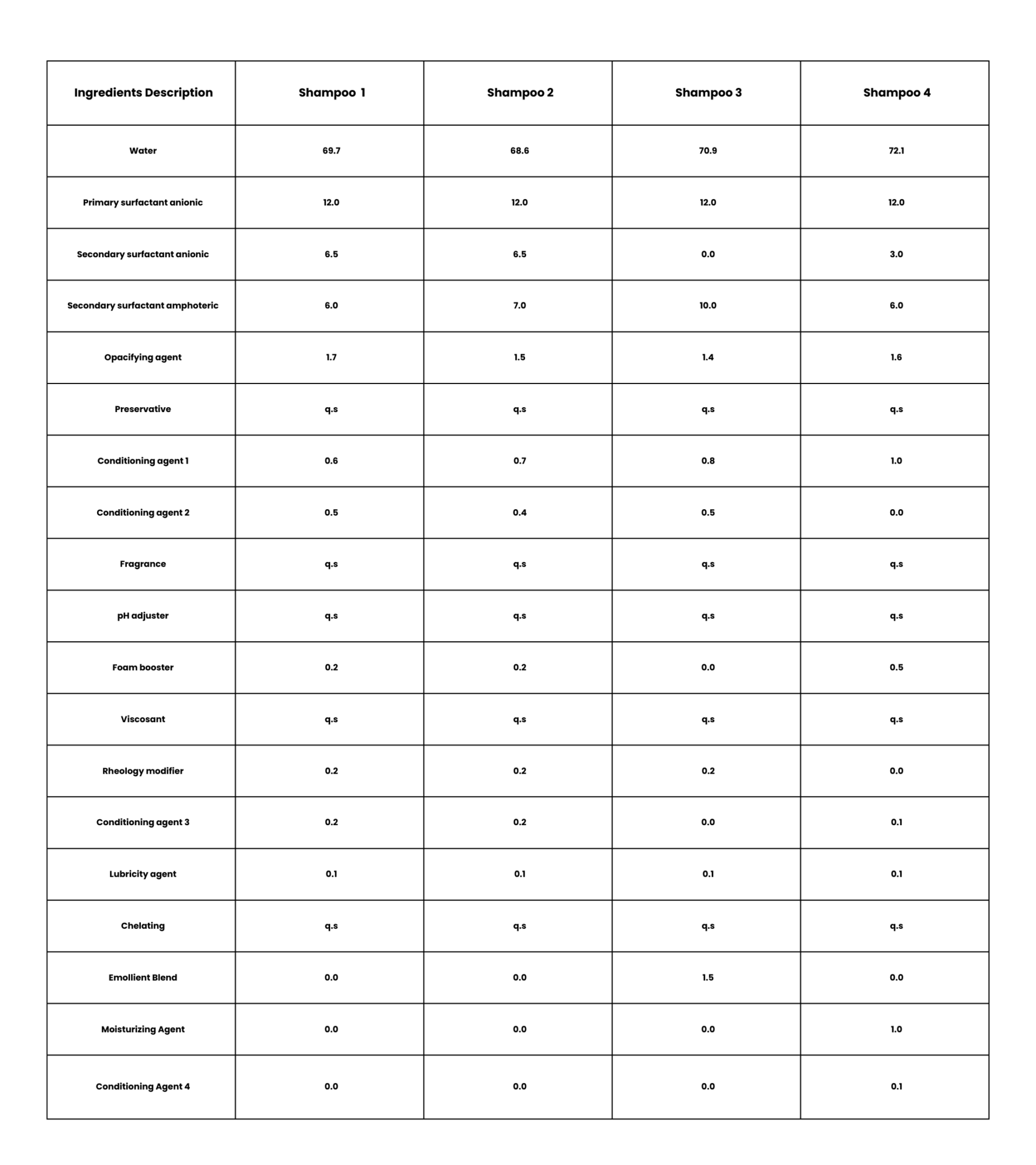
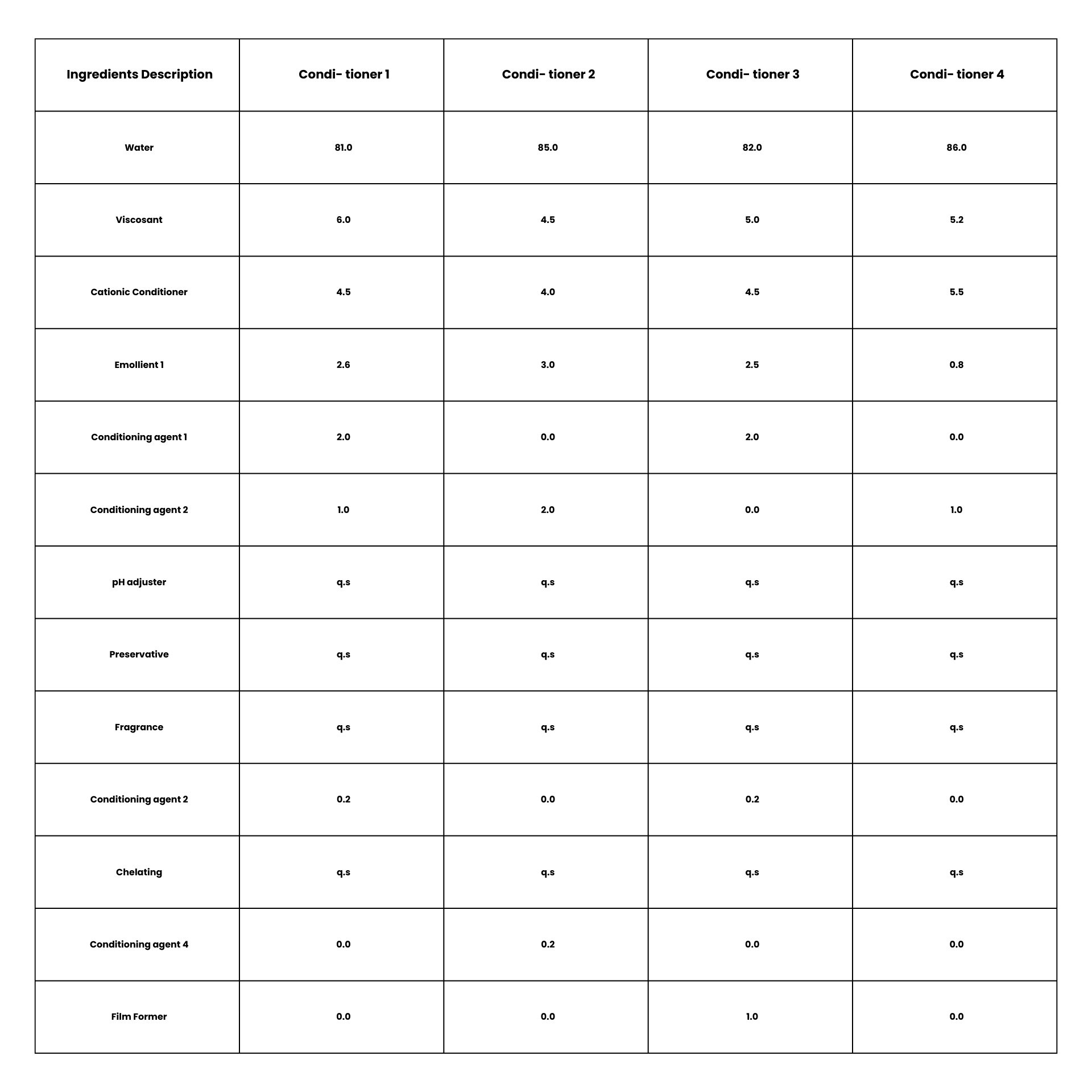
The formulations differ between them, in the percentage proportions of conditioning agents, emollients and secondary surfactants.
Laboratory evaluation
Then we tested the 8 formulations on Caucasian applying on tresses natural and treated in the laboratory. We measured combability through combing force evaluation. According to these results we selected two routines of Shampoo-conditioner to validate with users.
Tresses preparation. The study was conducted with 16 commercial Caucasian hair tresses (straight dark brown 4g/20cm net 2.5cm wide) per product. Half of the tresses were subjected to triple bleaching with a commercial product (potassium persulfate), with this treatment the two study groups are defined as natural/untreated (N) and treated/bleached (T). Tresses were previously washed using a 10% lauryl sulfate sodium solution for 1 min followed by 1 min of rinsing in 40°C tap water.
Equipment. Diastron MTT175 Miniature Tensile Tester Model. Measurement total work combability.
Tresses evaluation. First all tresses were reading at basal level in wet and dry conditions as a control reading in an initial condition. The application of four different formulas of shampoo and four different formulas of conditioner was carried out in each of the treatment groups (N and T). 0.5 ml of each product was applied and massaged for 1 minute, then rinsed for 30 seconds with a tap water and excess water was removed. Then, was carry out the measurement of combing and detangling on the Diastron equipment according to internal procedure. Duplicate measurements were performed.
Home test evaluation
A use test was carried out with heavy users of shampoo and conditioner. This test was carried out in Bogota city Colombia. 22 women with 20 to 40 years old participated in the study, ten of
them, with natural hair and twelve with treated hair.
For this study, two routines were given to the users, each with one shampoo and one conditioner formulations. The formulations chosen was the two best shampoo and the one best conditioner according to the results in the laboratory study. See Table 3.
The mode of use required to the users consisted in the application of routine during the shower, one on the first day of the study and the second routine on the day that they wash their hair according to personal hair care habits. A survey was carried out at the end of the application of each routine. The parameters evaluated were in wet hair and dry hair.
| Day 1 | First Shampoo 1 | First Conditioner 1 |
| Day 2 | Second Shampoo 2 | First Conditioner 1 |
Results Analysis
The results of the instrumental test were graphed thanks to the Minitab software in which the ANOVA statistic p <0.05 was applied.
For home test was used no parametric statistic. Wilkinson p < 0.05.
Results and Discussion
Laboratory Evaluation
Figure 1 shows the results of total work to combability for shampoo in wet and dry conditions on tresses. In the Figure 2 shows the same results for the conditioner.
In the red rectangular line, we can stand out the best performances in each parameter evaluated and that did not present a significant statistical difference p < 0.05.
Formula 1 presented the best results in wet and dry conditions. As you can see the combability value is lower except in wet conditions in natural hair (N). Related to Formula 2 and 3 wet combability had similar behavior in both types of hair. In dry conditions Formula 2 presents a similar performance to Formula 1 in treated hair T, meanwhile, Formula 3 presented the best performance in dry conditions for natural hair. Formula 3 was chosen because it had better behavior on dry hair in natural highlights vs Formula 2. Formula 4 was the one with the lowest performance both wet and dry.
Formula 1 has a specific secondary surfactant anionic that can be explained the performance on natural and treated, and formula 3 has a unique blend of conditioners, with these results we are presenting two interesting options to validate with the users.
In figure 2 we can see the behavior obtained for the four conditioner formulas in the two types of tresses. The graphs show that the conditioner that presented the best performance was conditioner 1 since it presented the lowest combability values in the two types of tresses, both wet and dry. Formula 2 has good behavior, but in wet natural tresses, it presents a significant difference vs formula 1, so the comb exerts greater force. In treated hair, formulas 1, 2, and 3 do not present a significant difference between them. Formula 4 was the one with the lowest performance both wet and dry.
Formula 1 has two conditioning agents, we consider the mix conditioning agent 1 at 2 % enhance the performance in combability and the unique combination with conditioning agent 2 at 1% that is strong softening agent can be explain the good performance obtained.
Home Use Test
The formulas chosen for the routine evaluation for shampoo were 1 and 3. The formula for conditioner chosen for the routine evaluation was 1.

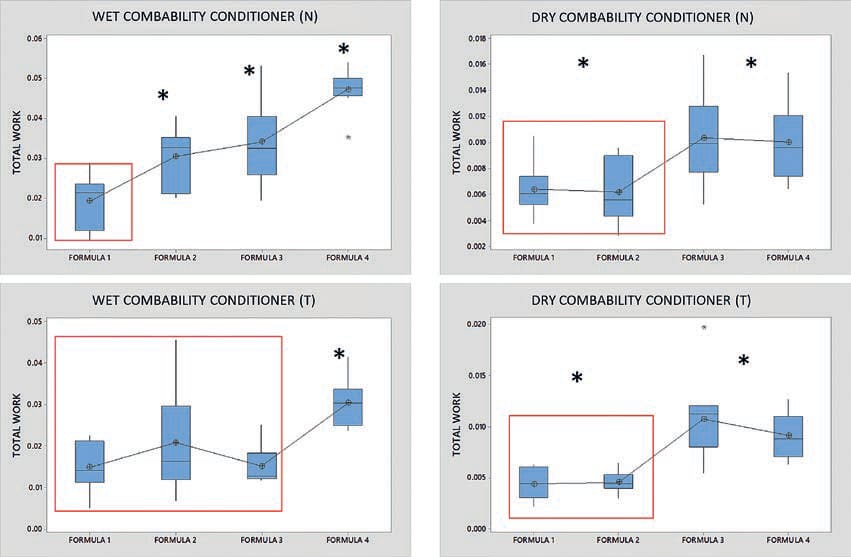
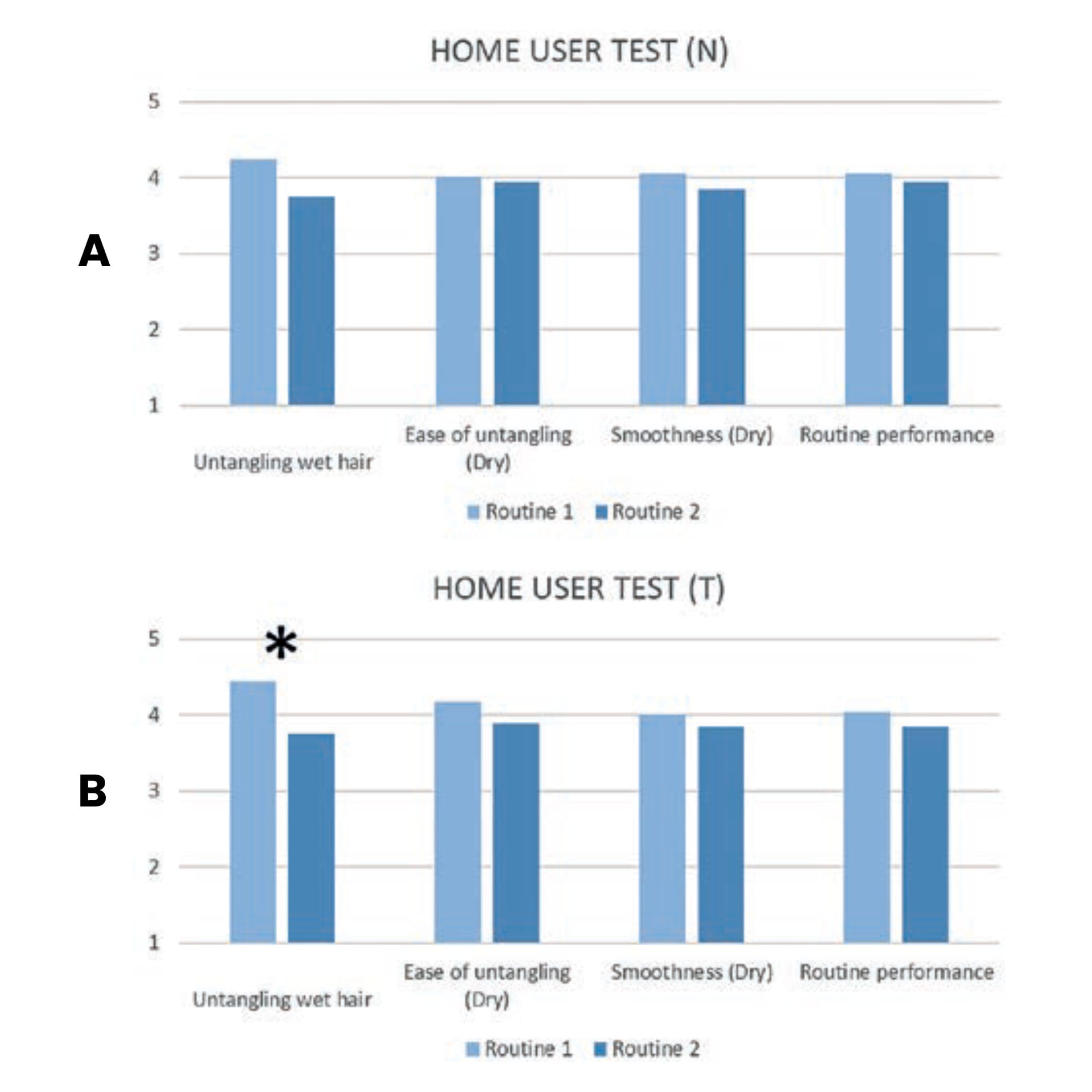
The survey was rated from 1 to 5 where 1 was the lowest score and five the highest score for the users indicating that which was their perception.
The figures 3 shows the result about the home test use.
For natural hair users, attributes such as wet detangling and dry smoothness were more appreciated with routine 1, and there is a significant difference from routine 2. While dry detangling ease and performance of the routine still score better for routine 1, there is no significant difference.
The two routines presented good results in the preliminary home test in all parameters evaluated. Analyzing these results using a non-parametric statistic p <0.05, statistically significant difference was found for wet detangling for users with treated hair. We can see a trend for dry detangling and smoothness with the routine 1 indicating a potential better performance and liking for this routine.
We can observe that the routine with the Shampoo 1, that was the best qualified in the laboratory test with the best conditioner probably will present best performance for two types of hair, natural and treated. We suggest the routine 1 (Shampoo 1/Conditioner 1) for the user with the two types of hair evaluating them in a sample home test more representative.
Conclusions
In our market in Latam, we have great diversity in hair, and for that reason is very important develop formulation base that can have good performance in all type of hair. This work contributes to validate formulation base that can be useful to start the development process of basic routines for different consumers.
Acknowledgement
The authors give thanks to Belcorp for all support and motivation in the realization for this work. Specially thanks to Vanessa Gonzalez for the support during the execution of this project.
References
- IMARC Impactful insights. Hair Care Market: Global Industry Trends, Share, Size, Growth, Opportunity and Forecast 2023–2028. Report ID: SR112023A898. Available at: Hair Care Market Size, Share, Trends and Industry Analysis 2023-2028 (imarcgroup.com). Accessed April 2023.
- Souza P, Rathi S. Shampoo and Conditioners: What a Dermatologist Should Know?. Indian Journal of Dermatology. 60(3). 2015.
- Reis Gavazzoni Dias, M. Hair cosmetics: an overview. Int J Trichology. Jan-Mar;7(1):2–15. 2015.
- Bhushan B. Biophysics of Human Hair, Biological and Medical Physics, Biomedical Engineering. New York: Springer-Verlag Berlin Heidelberg. p. 1–19. 2010.



